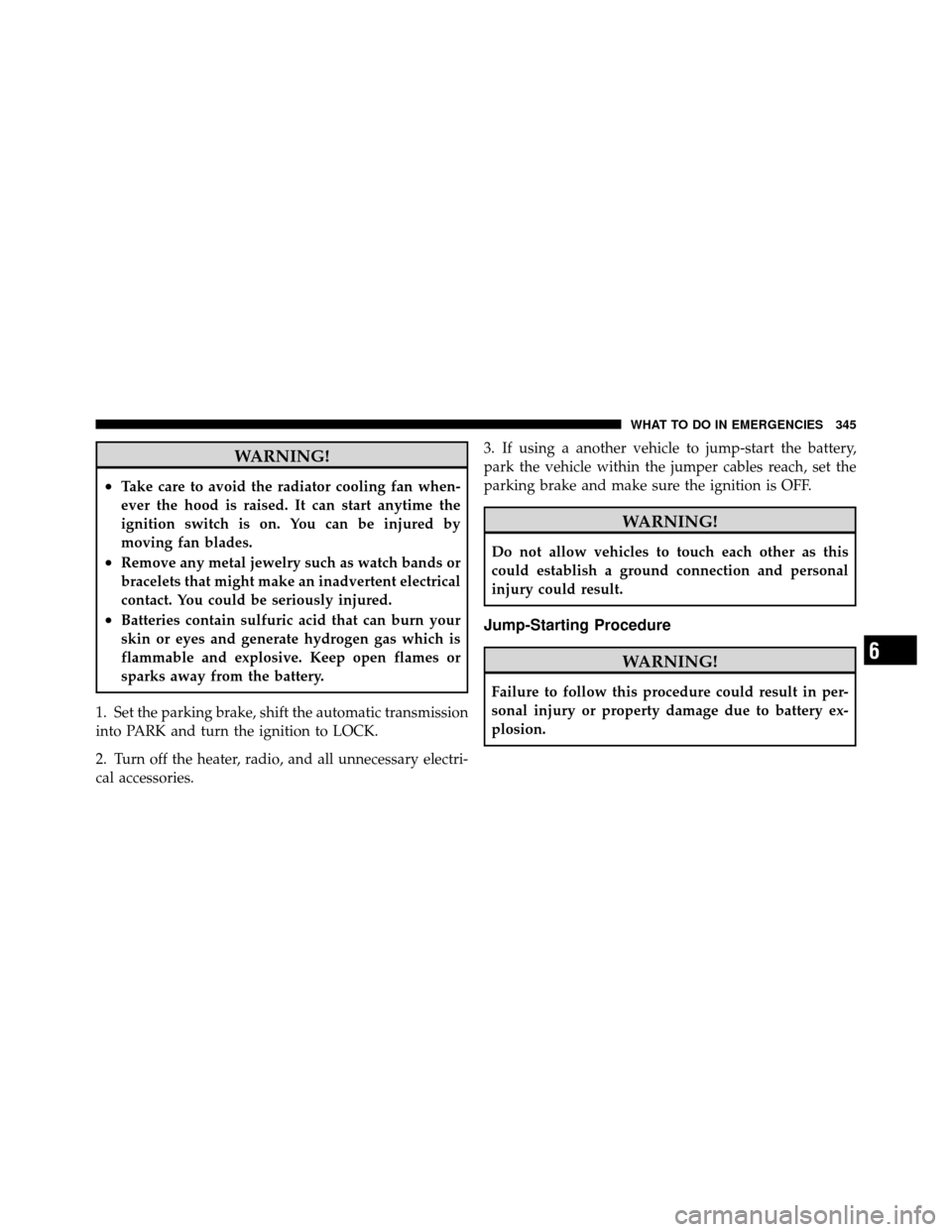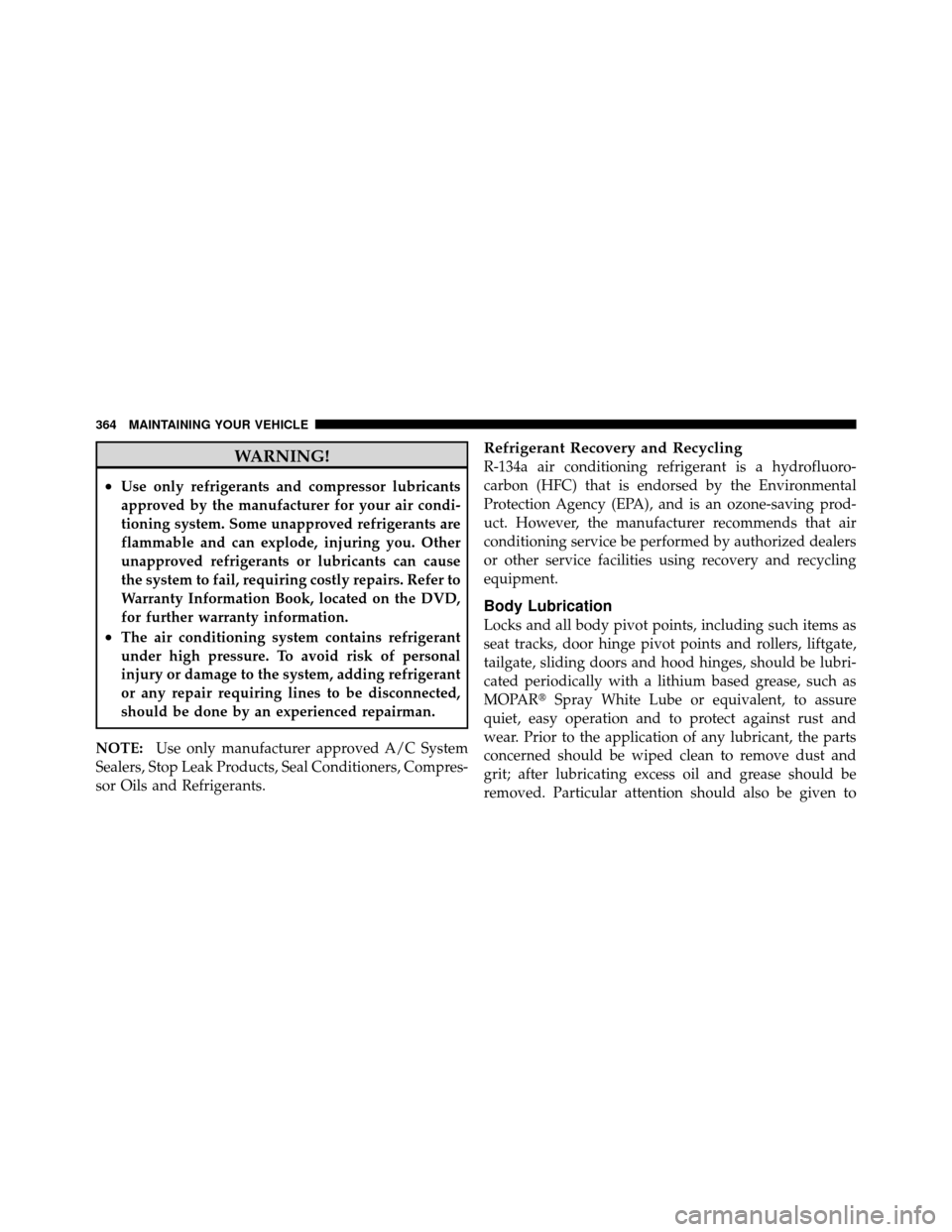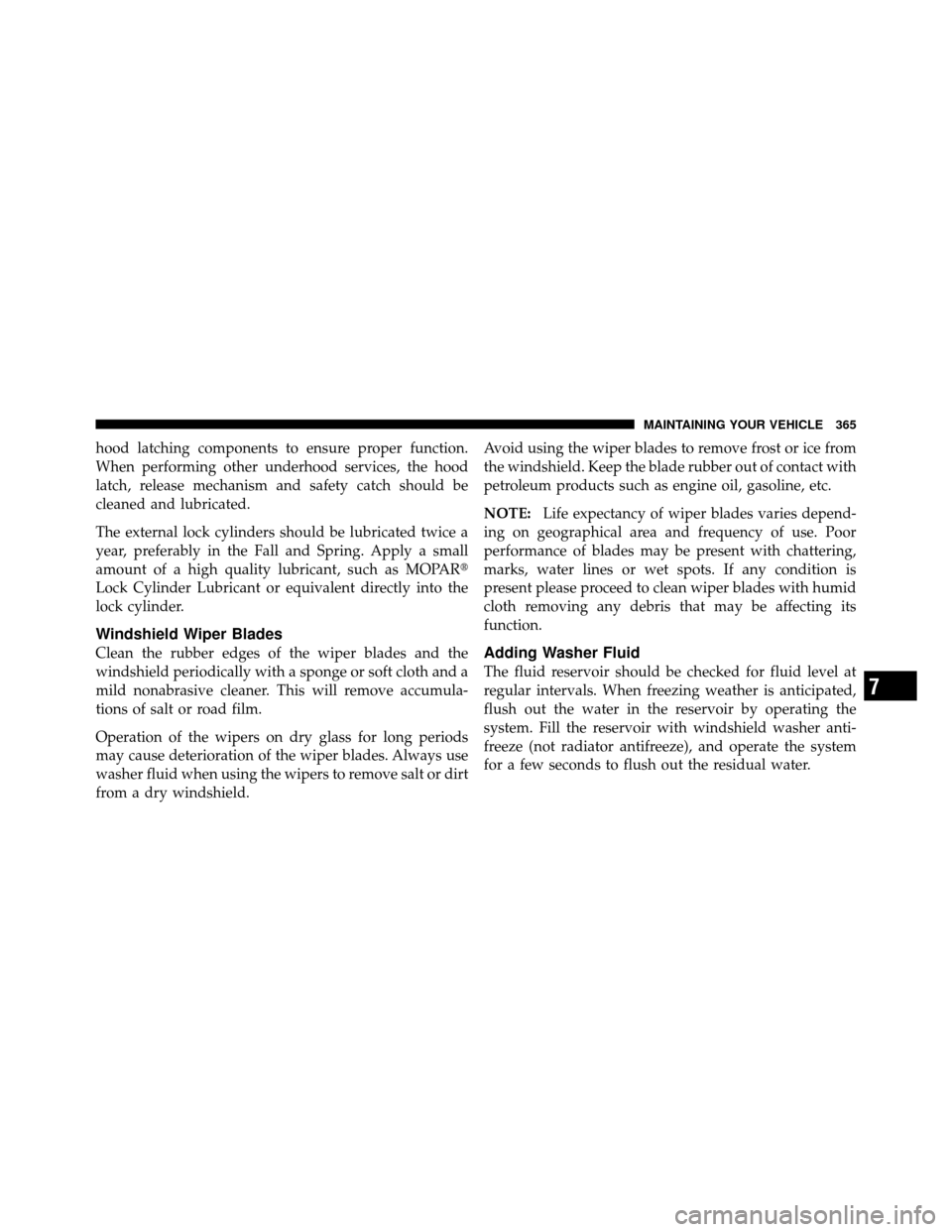Page 346 of 450

WARNING!
•Take care to avoid the radiator cooling fan when-
ever the hood is raised. It can start anytime the
ignition switch is on. You can be injured by
moving fan blades.
•Remove any metal jewelry such as watch bands or
bracelets that might make an inadvertent electrical
contact. You could be seriously injured.
•Batteries contain sulfuric acid that can burn your
skin or eyes and generate hydrogen gas which is
flammable and explosive. Keep open flames or
sparks away from the battery.
1. Set the parking brake, shift the automatic transmission
into PARK and turn the ignition to LOCK.
2. Turn off the heater, radio, and all unnecessary electri-
cal accessories. 3. If using a another vehicle to jump-start the battery,
park the vehicle within the jumper cables reach, set the
parking brake and make sure the ignition is OFF.
WARNING!
Do not allow vehicles to touch each other as this
could establish a ground connection and personal
injury could result.
Jump-Starting Procedure
WARNING!
Failure to follow this procedure could result in per-
sonal injury or property damage due to battery ex-
plosion.
6
WHAT TO DO IN EMERGENCIES 345
Page 365 of 450

WARNING!
•Use only refrigerants and compressor lubricants
approved by the manufacturer for your air condi-
tioning system. Some unapproved refrigerants are
flammable and can explode, injuring you. Other
unapproved refrigerants or lubricants can cause
the system to fail, requiring costly repairs. Refer to
Warranty Information Book, located on the DVD,
for further warranty information.
•The air conditioning system contains refrigerant
under high pressure. To avoid risk of personal
injury or damage to the system, adding refrigerant
or any repair requiring lines to be disconnected,
should be done by an experienced repairman.
NOTE: Use only manufacturer approved A/C System
Sealers, Stop Leak Products, Seal Conditioners, Compres-
sor Oils and Refrigerants.
Refrigerant Recovery and Recycling
R-134a air conditioning refrigerant is a hydrofluoro-
carbon (HFC) that is endorsed by the Environmental
Protection Agency (EPA), and is an ozone-saving prod-
uct. However, the manufacturer recommends that air
conditioning service be performed by authorized dealers
or other service facilities using recovery and recycling
equipment.
Body Lubrication
Locks and all body pivot points, including such items as
seat tracks, door hinge pivot points and rollers, liftgate,
tailgate, sliding doors and hood hinges, should be lubri-
cated periodically with a lithium based grease, such as
MOPAR� Spray White Lube or equivalent, to assure
quiet, easy operation and to protect against rust and
wear. Prior to the application of any lubricant, the parts
concerned should be wiped clean to remove dust and
grit; after lubricating excess oil and grease should be
removed. Particular attention should also be given to
364 MAINTAINING YOUR VEHICLE
Page 366 of 450

hood latching components to ensure proper function.
When performing other underhood services, the hood
latch, release mechanism and safety catch should be
cleaned and lubricated.
The external lock cylinders should be lubricated twice a
year, preferably in the Fall and Spring. Apply a small
amount of a high quality lubricant, such as MOPAR�
Lock Cylinder Lubricant or equivalent directly into the
lock cylinder.
Windshield Wiper Blades
Clean the rubber edges of the wiper blades and the
windshield periodically with a sponge or soft cloth and a
mild nonabrasive cleaner. This will remove accumula-
tions of salt or road film.
Operation of the wipers on dry glass for long periods
may cause deterioration of the wiper blades. Always use
washer fluid when using the wipers to remove salt or dirt
from a dry windshield. Avoid using the wiper blades to remove frost or ice from
the windshield. Keep the blade rubber out of contact with
petroleum products such as engine oil, gasoline, etc.
NOTE:
Life expectancy of wiper blades varies depend-
ing on geographical area and frequency of use. Poor
performance of blades may be present with chattering,
marks, water lines or wet spots. If any condition is
present please proceed to clean wiper blades with humid
cloth removing any debris that may be affecting its
function.Adding Washer Fluid
The fluid reservoir should be checked for fluid level at
regular intervals. When freezing weather is anticipated,
flush out the water in the reservoir by operating the
system. Fill the reservoir with windshield washer anti-
freeze (not radiator antifreeze), and operate the system
for a few seconds to flush out the residual water.
7
MAINTAINING YOUR VEHICLE 365
Page 388 of 450
CavityCartridge
Fuse Mini-
Fuse Description
16 20 Amp
YellowHorn
17 20 Amp
YellowABS Feed (Valves)
18 20 Amp
YellowFuel Pump
19 15 Amp
BlueCenter High-Mounted
Stop Light (CHMSL)
20 20 Amp
YellowCabin Compartment
Node (CCN) Door
Locks/Brake Trans-
mission Shift Inter-
lock (BTSI)
21 25 Amp
NaturalAudio Amp
22 20 Amp
YellowPower Outlet (Switch-
able)Cavity
Cartridge
Fuse Mini-
Fuse Description
23 20 Amp
YellowFog Lamps
24 20 Amp
YellowPowertrain Control
Module (PCM) B+
25 15 Amp
BlueCabin Compartment
Node (CCN) Illumi-
nation
26 20 Amp
YellowIgnition Run/Start
Feed
27 10 Amp
RedPower Mirror
28 20 Amp
YellowPower Outlet
29 20 Amp
YellowFront Control Module
(FCM) 4 (Wipers)
30 Spare
7
MAINTAINING YOUR VEHICLE 387
Page 390 of 450
CavityCartridge
Fuse Mini-
Fuse Description
47 Spare
48 20 Amp Blue Sunroof/Sound Box
49 30 Amp Pink Trailer Tow B+
50 40 Amp Green Anti-Lock Brake Sys-
tem (ABS) Module
(Pump)
51 40 Amp Green Park Lamps
52 Spare
53 40 Amp Green Rear Defogger
54 Spare
55 SpareCavityCartridge
Fuse Mini-
Fuse Description
56 10 Amp
RedHeated Seats
57 20 Amp
YellowAirbag System # 2
58 20 Amp
YellowHeated Seats
59 10 Amp
RedHVAC Module
60 10 Amp
RedABS Module
61 20 Amp
YellowFront Control Module
(FCM) 3 (Reverse
Lamps)
7
MAINTAINING YOUR VEHICLE 389
Page 391 of 450

VEHICLE STORAGE
If you are storing your vehicle for more than 21 days, we
recommend that you take the following steps to mini-
mize the drain on your vehicle’s battery:
•Disconnect the Ignition Off Draw (I.O.D.) fuses located
in the Power Distribution Center (PDC). The I.O.D.
cavity includes a snap-in retainer that allows the fuse
to be disconnected without removing it from the fuse
block.
•The transfer case should be placed in the 4HI mode
and kept in this position to minimize the battery drain.
•As an alternative to the above steps you may discon-
nect the negative cable from the battery.
REPLACEMENT BULBS
LIGHT BULBS – InteriorBulb No.
Dome Lamp ........................ WL212–2
Cargo Lamp ............................ 921
Overhead Console Lamps ................... 192
Reading Lamp ...................... WL212–2
LIGHT BULBS – Exterior Bulb No.
Headlamp ............................. H13
Front Park/Turn/Side Marker ............3157NA
Back-Up .............................. 3157
Center High Mounted Stop Lamp ............. 921
Fog Lamp ............................. 9145
License Plate Lamp ....................... 168
Rear Tail, Stop, Turn Signal .................3057
390 MAINTAINING YOUR VEHICLE
Page 392 of 450
BULB REPLACEMENT
Headlamp (Halogen)/Front Park and Turn Signal
Lamps
1. Open the hood
2. Remove the three bolts from the front of the headlamp
housing.3. Grasp the headlamp and pull firmly to disengage the
headlamp housing from the fender panel.
4. While firmly holding the headlamp housing in your
hands, unlock and disconnect headlamp bulb connector.
5. Twist 1/4-turn and remove headlamp bulb from hous-
ing and replace.
7
MAINTAINING YOUR VEHICLE 391
Page 394 of 450
2. Pull the taillamp housing straight out from the body. 3. Rotate the bulb socket counterclockwise to remove itfrom the housing.
7
MAINTAINING YOUR VEHICLE 393